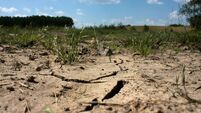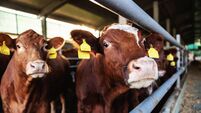Brian Reidy: Can any of these calves selling for €500+ make a profit?

If there is any drop in confidence for those that invest in calves each year, through a drop in factory or mart prices, then calves will be a tough trade in the spring of 2026. Picture: O'Gorman Photography
We are calving at home at the moment, and all is going well, thankfully. I have last year's bull calves entered in the Cahir Mart Weanling Show and Sale for this Friday, so it’s a busy time of year.
I have been asked many times recently by readers and customers if the high-price calves bought this year will ever leave a margin. My immediate reaction is to suggest that I am a ruminant nutritionist and not a fortune-teller.
There are many hurdles for the industry to jump between now and then. If there is any drop in confidence for those that invest in calves each year, through a drop in factory or mart prices, then calves will be a tough trade in the spring of 2026.
But as we know, there is a significant drop in the national herd as a lot fewer suckler and dairy-bred calves have been registered this year so far.
Couple this with the volume of calves and weanlings that have left our shores by boat so far this year, and we for certain will have many fewer animals slaughtered in Ireland in the next two years, at a minimum.
For those who purchased these calves earlier in the year at much higher prices than in previous years, it is critical that growth and gain are optimised all the way through to slaughter.
Regular weighing to measure performance and identify underperforming individuals or groups will be an important tool. We are now in September, and the feed value of grass has, as normal, dramatically dropped off.
To make sure that these calves/weanlings continue to fulfil their genetic potential, then, firstly, you must offer these calves/weanlings the very best quality grass you have available on the farm and in many cases, it will be necessary to begin introducing supplementation in the form of concentrates and/or a quality forage source.
These animals will also benefit from earlier housing to reduce stress as weather conditions deteriorate, days get shorter, and energy intakes drop off. Housing stress, along with nutritional stress, will result in a very negative impact on animal performance.
The quality of your silage is the next thing to consider in the growth and development of these calves/weanlings. Keeping these animals achieving close to 0.8 to 1kg gain per day is what you should be aiming for.
The more they have grown, the better, so that by the time of turn out next spring, they have a big capacity to consume grass and push on next summer.
By doing this, you have a well-advanced store animal for sale or housing for further feeding. Testing your silage and supplementing it with an appropriate concentrate throughout the coming winter will be key to optimising daily gain and frame growth.
Keep silage as fresh as possible to avoid digestive upsets and problems with moulds causing mycotoxin issues. Feed silage fresh daily if possible, as this will optimise daily dry matter intakes.
Whatever you do, don’t skimp on protein supplementation for these animals, as underfeeding protein depresses intake and low intakes mean low energy intakes and then animals don’t grow and thrive as they should.
A targeted vaccination and dosing programme should be devised with the help of your vet to avoid unnecessary losses and poor thrive. Use farm history, local knowledge and sampling of dung and bloods, if necessary.
Pay attention to ventilation in the sheds that they will be housed in for the winter, and remember to stock pens appropriately so that they will fit comfortably at the end of the winter.
This will also help to optimise performance and reduce the risk of injury. The less re-batching and moving you have to do during housing, the better.













